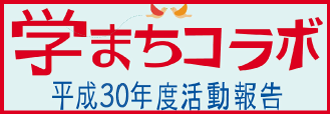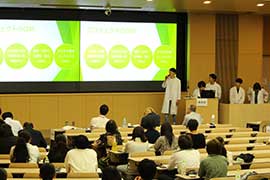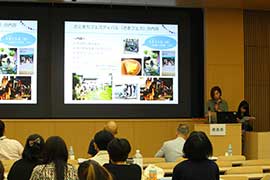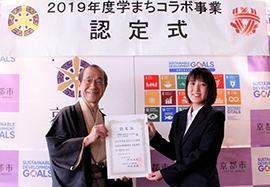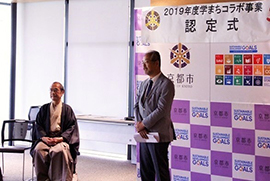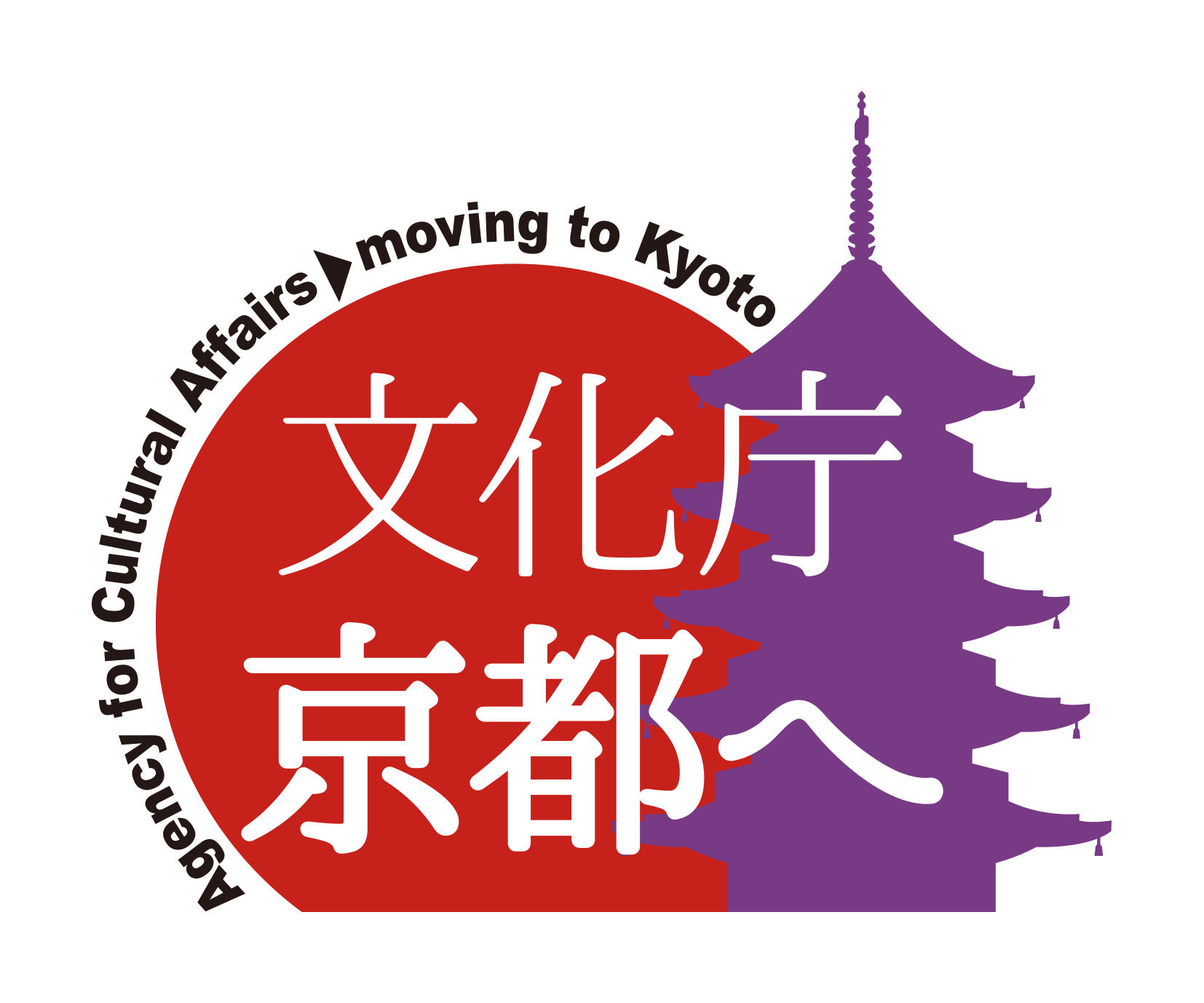- Business Overview
- Target Businesses
- Target Organizations
- Amount and number of donations
- About the application
- Main Schedule for the Future
- Selection Results
- Implementation Report
- Learning Town NEWS!
- Inquiries
Business Overview
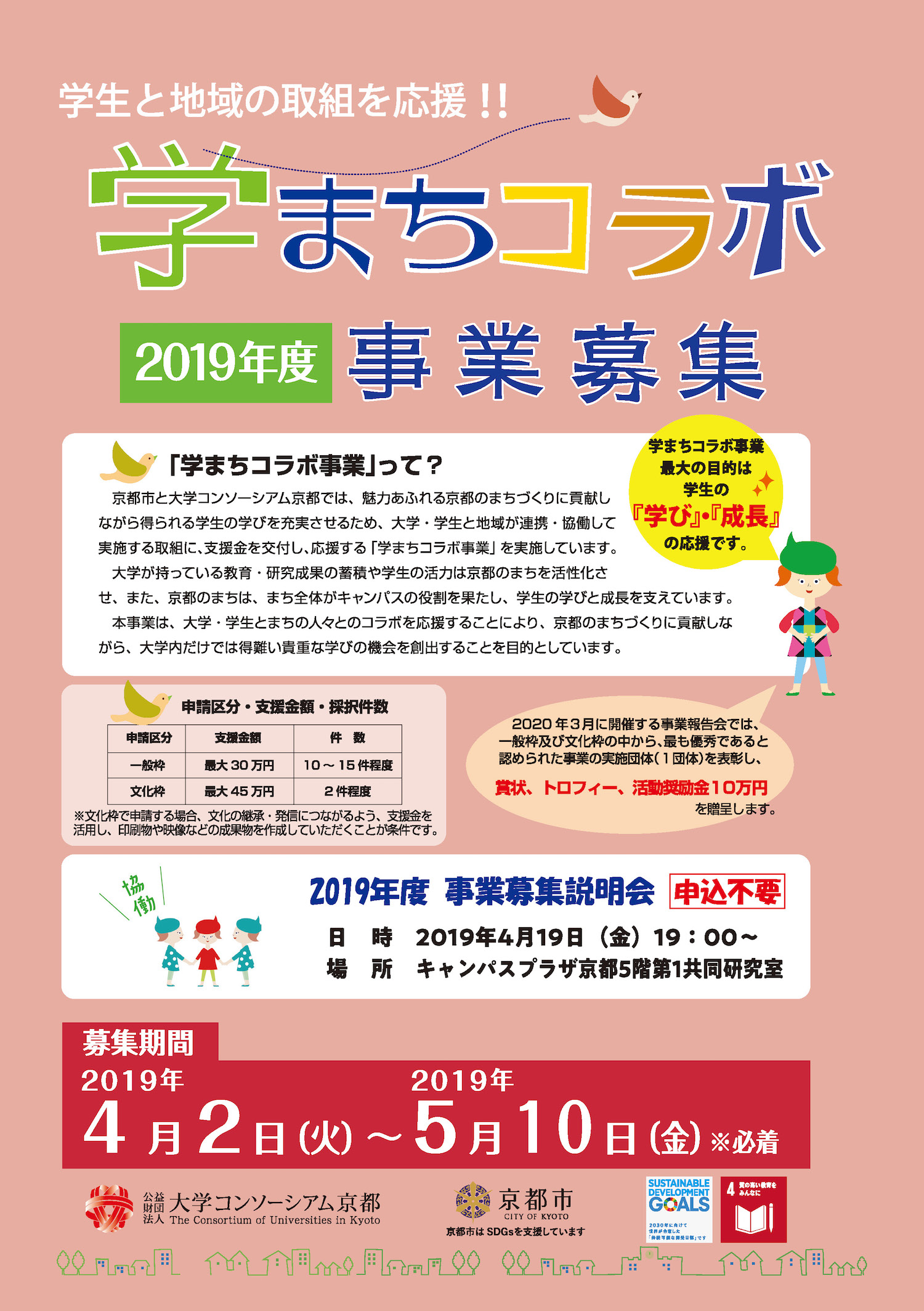
Kyoto City and the University Consortium Kyoto are implementing the “University Regional Collaboration Creation and Support Project (nicknamed the Gakumachi Collaboration Project)” to support the efforts by granting support funds to projects and projects that work on urban development and regional revitalization in Kyoto through “collaboration” between universities, students, and local communities.
This year marks the 16th year of the program, with the aim of developing human resources by securing practical education and research opportunities for universities, and for local communities, to solve local issues and revitalize them through the knowledge of the university and the vitality of students.
|
Target Businesses
With the aim of solving local issues and revitalizing the city of Kyoto, projects that meet the following requirements ((1) and (2) for the general category and (1), (2), and (3) for the cultural category) will be implemented in Kyoto City during the fiscal year 2019 (from the date of adoption to the end of March of the following year) are eligible.
However, political activities, religious activities, activities that promote specific ideas, violent or destructive activities, commercial businesses, etc. are excluded.
* Projects applied for the cultural category may be selected in the general category.
* Projects applied for the general category will not be selected for the cultural category.
[Common requirements for general and cultural frameworks]
(1) Projects in which universities and student groups and local communities (residents’ organizations, civic activity groups, businesses, etc., mainly in the Kyoto City area) collaborate and collaborate as organizations and groups, and in particular, students take the initiative in their activities.
* Administrative agencies may be included as collaborators, but cooperation with administrative agencies alone is not possible.
Examples: Health and welfare, social education, community development, promotion of academic, cultural, artistic or sports, environmental conservation,
Surveys and research in various fields such as community safety, citizen lectures, events, etc.
(2) Those who have not received any subsidies or subsidies from Kyoto City other than the Gakumachi Collaboration Project.
[Requirements for the cultural quota only]
(3) Priority Theme: “Culture of the Region”
In addition to the requirements of (1) and (2), it is necessary to dig up the culture that lies dormant in the region and to pass on the culture that has been passed down from generation to generation in the region.
Projects that work on dissemination to preserve for the future, or to create a new culture through the knowledge of the university and the vitality of its students.
Businesses to work on.
In order to inherit and archive local culture, it is necessary to disseminate the results of activities in print and video.
* “Culture” includes lifestyles and customs such as art, performing arts, events, industry, food, clothing, housing, etc., as well as old and new.
There are diverse aspects.
Universities, student groups, and the local community themselves should carry out activities from the perspective of “this is culture.”
Target Organizations
Organizations and groups of University Consortium, Kyoto member universities and junior colleges (*1)
or
A local organization that mainly works in the Kyoto city area (*2)
(*1) University departments, laboratories, seminars, clubs, student circles
〈Circles made up of students from multiple universities are also possible〉, etc.
*2 Residents’ organizations such as residents’ associations and neighborhood associations, civic activity groups, groups and groups consisting of businesses, etc. (shopping streets, etc.)
![]() Kyoto City Collaborative Project
Kyoto City Collaborative Project
Amount and number of donations
General category: Up to 300,000 yen / 10-15 cases
Cultural quota: Up to 450,000 yen / about 2 projects
* However, if you apply for the cultural quota, you will be required to use the support money to create deliverables such as printed materials and videos so that it will lead to the inheritance and dissemination of culture.
* At the project report meeting scheduled to be held in March 2020, the implementing organization (1 organization) that is recognized as the most outstanding will be awarded (a certificate, trophy, and an activity incentive of 100,000 yen will be issued separately).
About the application
Application period [Application for 2019 has ended]
Tuesday, April 2, 2019 ~ Friday, May 10, 2019
* If you send it by mail, it must arrive on the same day, and if you bring it by 5 p.m.
FY2019 Business Recruitment Briefing <終了>
- Date:
- , April 19, 2019 19:00〜
- Venue:
- Campus Plaza Kyoto 5F 1st Joint Laboratory
We also accept questions about how to write an application.
Friday
How to apply: Step 1 Before you start writing your application <終了>
It is recommended to read the master plan of the administrative district in which the activity will be carried out. In addition, please listen to the opinions of local people and related government agencies as much as possible regarding the background of the project implementation and the needs of the community. If you have any questions about the basic plan of the ward or points to keep in mind when working in the community, you can also consult with the Regional Power Promotion Office of each ward office or branch. In addition to reconfirming and sharing your objectives and goals, let’s discuss and think again about whether the business you are thinking about is the best way to achieve your goals. In addition, with regard to continuing projects, let’s thoroughly summarize the efforts we have made so far.
How to apply: Step 2 Let’s write an application! <終了>
● 2019 Application Guidelines
● 2019 Application Form (Microsoft WORD)
● Example of filling out an application form
● Notes on inclusion in the budget
|
Points to fill in |
○ Let’s check the judging criteria! In particular, the first screening is all about the submitted documents. Let’s find out what criteria are used to judge the case. ○ What is the purpose of the project? Write down your purpose and local needs. The group that listened to the opinions of local people and ward offices in step 1 should also write the contents. ○ Who are you collaborating with? What does each of them do? Let’s be specific. The Gakumachi Collaboration emphasizes learning that can be obtained by collaborating with the university, students, and the community toward the same goal. If a student group is applying, write down what role the partner will play, and if a local organization is applying, write down what the student will do independently. |
How to apply: Step 3 Register your business outline <終了>
Please register your business outline using the form below.

Registration has been closed.
How to apply: Step 4 Submission of application documents <終了>
Please submit it by mail or bring it to the following address within the application period.
(1) 15 copies of application documents *If there are reference materials (up to 10 sheets), submit 15 copies of reference materials
(2) Application document data (MS-Word) * If reference materials are available, submit reference data (PDF) as well.
* Please do not change the prescribed form downloaded from the University Consortium Kyoto website for both (1) and (2).
Main Schedule for the Future
1st screening: After the application deadline ~ mid-June *Document screening
Second screening: Sunday, June 23, 2019
Notification of support project decision and selection results: Early July 2019
Approval ceremony: Early ~ mid-July 2019 * A certificate will be issued by Kyoto City for the selected projects.
Interim Report: Mid~Late October, 2019 *Submission of documents
Final report: March 2020 *Submission of documents
Announcement: Mid~end of March, 2020
Selection Results
First Screening (Document Screening)
Organizations that passed the first selection: 3 projects in the cultural category, 20 projects in the general category
Second Selection (Public Presentation Judging)
On June 23, 2019, the second selection meeting (public presentation judging meeting) was held, and the following two cultural projects,
Twelve general projects were certified as support projects.
2019 Gakumachi Collaboration Project Certified Project List (in order of application)
(Cultural Framework)
| Project Name |
Name of Organization【Name of Affiliated University】 Outline of the Administrative Region |
Project |
|---|---|---|
| Soikal from Shizuhara ~Dissemination of Kyoto Soybean Food Culture~ |
Mirai Transmission Station Omusubi ~Shizuhara Support Team~ [Kyoto Sangyo University] Administrative District: Sakyo Ward |
aim of local production for local consumption of soybeans, which are indispensable ingredients for Kyoto cuisine and symbolize Kyoto’s food culture, and the transmission of food culture, we will collaborate with the Shizuhara area to cultivate Kyoto soybeans “Otsuru”, hold events related to soybeans, develop products, etc., in order to disseminate the appeal of soybeans and improve their status. |
| Disseminating the new role of temples through the activities of Tera*Parumusu | Ryuganji Cultural Affairs Department Tera*Parumu [Seian University of Art and Design, Kyoto City University of Arts, Kyoto Tachibana University] Administrative area: Shimogyo Ward |
With the aim of making the temple a place for local people to interact, events such as live performances on the theme of Buddhism and explanations of scriptures by the priest will be held as an opportunity to visit the temple on a daily basis. In addition, through the event, we will raise awareness of Buddhist culture, which is involved in various aspects of people’s lives, and lead to the inheritance of culture in Kyoto, which has many temples. |
(General category)
| Project Name | Name of Organization【Name of Affiliated University】 Outline of the Administrative Region |
Project |
|---|---|---|
| Environmental protection of Fushimi Fukakusa and Higashitakase rivers Jizo Bon Project |
Ryukoku University, environmental protection of the Higashitakase River Jizo Bon Project Team 【Ryukoku University Junior College】 Administrative District: Fushimi Ward |
In order to pass on the traditional events of the region to the next generation and to improve the environment of the Higashitakase River, which will be the venue, we will collaborate with the local community to carry out river cleanup activities, plan and operate the “Jizo Bon Program,” and support disaster prevention activities and disaster drills, while involving high school students and others. |
| KOKA☆Orange Project ~ Let’s support “food” for the elderly and people with disabilities! ~ |
KOKA☆ Orange Supporters 【Kyoto Koka Women’s University】 Administrative District: Ukyo Ward |
In order to contribute to the realization of a richer life for the elderly and people with disabilities in the community, we will develop new products of “soft Japanese sweets” that are easy to swallow, and hold events to introduce and provide them. In addition, we will prepare pamphlets describing training methods for maintaining the ability to eat, and distribute them to facilities and other facilities to raise awareness of “eating deliciously and safely.” |
| Keihoku Utsu Fureai Learning Mutual | Kyoto Seika University Keihoku Uzu Treasure Search 【Kyoto Seika University】 Administrative District: Ukyo Ward |
the aim of revitalizing the Uzu area, which is blessed with abundant nature, history, and culture, but is aging and depopulated, we are working on holding exchange events such as Keihoku Music Festa and Children’s Festa, participating in traditional events such as summer festivals and evil god festivals, organizing materials and exhibitions at the former Uzu Elementary School, and holding handmade markets. |
| Camo Cinema 15 | Camo Cinema 15 executive committee [Ritsumeikan University] Administrative District: Kamigyo Ward |
In order to raise young people’s awareness of environmental conservation in the Kamo River, cleanup activities and participatory hands-on events will be held during the day, and outdoor movie screenings will be held after sunset in the Kamo River. This year, we will deepen our efforts with the following three objectives: “Raise awareness of environmental conservation among young people and other local residents through these initiatives,” “Establish the event itself in the community as a ‘summer tradition’ that local residents can enjoy every year,” and “Realize initiatives that will serve as an opportunity to discover and take an interest in the further attractions of the Kamo River.” |
| Children’s Science Classroom | Exciting Laboratory [Bukkyo University] Administrative District: Kamigyo Ward |
In the Kitano shopping street area of Kamigyo Ward, in order to create a place for children to belong and to create opportunities for children and their parents to visit the shopping street, free science experiment classes will be held during the after-school hours on weekdays, and this year we will try to hold holidays to expand the number of participants. In addition, in addition to participating in the “Kitano Town Development Council” and striving to understand the needs of the shopping street, we will also exhibit a booth at events hosted by Kitano Shopping Street, such as summer festivals and Halloween. |
| Halloween in Saiin | Halloween in Executive Committee of the Western House [Kyoto University of Foreign Studies] Administrative District: Ukyo Ward |
the aim of strengthening ties with local residents, shops, and students around Shijo-dori, we will hold a Halloween parade from Kyoto University of Foreign Studies to Hankyu Saiin Station in which students and local people can participate, and as related events, we will hold workshops at children’s centers and projects in collaboration with the Yoin Halloween Festival. |
| Daigo Zhongshan Complex Revitalization Projects |
Kyoto Tachibana University Society for Contemporary Business Studies [Kyoto Tachibana University] Administrative districts: Yamashina Ward, Fushimi Ward |
order to promote Shimizu ware, a traditional craft in Kyoto, and to increase the number of places for interaction between the elderly and the child-rearing generation at the Daigo Nakayama Housing Complex in Fushimi Ward, we will hold a lighting event “Pottery Lantern Road” using Shimizu pottery, as well as a workshop to clean up the venue and make accessories using Shimizu ware to be exhibited at events. Through the holding of Christmas parties, we will promote exchanges among local residents. |
| Higashi Kujo / Memory Mapping |
Taji Laboratory, Kyoto University Higashikujo Town Development Team [Kyoto University] Administrative District: Minami Ward |
In light of the fact that the number of storytellers who know the history of the Higashi-Kujo area is decreasing due to the aging of the population, we will conduct interviews about the past of the city and record it on a map so that it can be used as a medium for sharing memories of the past by local residents and people involved in the Higashi-Kujo area in the future, and it will be used as a basis for the future image of the region. |
| Circle-like self-government activities in Rakusai New Town | Kyoto Women’s University Eriko Inoue Laboratory Bamboo Village, Shinrin-Team [Kyoto Women’s University] Administrative Region: Xijing Ward |
In the Rakusai Takenosato Housing Complex, where the local community is sparse and there are no autonomous organizations such as neighborhood associations, based on the need for “human relationships that can help each other in the event of a disaster,” we will create circle activities triggered by residents’ areas of expertise and hobbies, and work to solve local issues by linking these circles. This fiscal year, we will expand our base of activities to the Rakusai Shinrin-Complex and promote cooperation among the complexes, which will lead to the revitalization of the entire region. |
| Community-based Bamboo Forest Maintenance and Bamboo Education Project ~Oharano and Arashiyama Districts as Fields~ | Kyoto Prefectural University Forest Volunteer Circle Mori Nakama [Kyoto Prefectural University] Administrative Districts: Ukyo Ward, Nishikyo Ward |
In order to prevent the spread of neglected bamboo forests in the Oharano area, to improve and maintain the scenery of bamboo forests in the Arashiyama area, and to raise awareness among tourists, we will cooperate with local organizations to maintain bamboo forests such as cutting bamboo and sprinkling bamboo chips in the forest. In addition, we will hold a tree (bamboo) work experience event for parents and children with the participation of local residents, and provide opportunities for them to feel close to the bamboo forest and disseminate the appeal of bamboo forests and bamboo wood. |
| Kyoto Bunkyo University Bus Tours | Kyoto Bunkyo University Bus Tours [Kyoto Bunkyo University] Administrative District: Fushimi Ward |
In Mukojima New Town, where the aging of the population is progressing and the withdrawal of the elderly is a problem, we will conduct a one-day bus tour using a school bus (to and from Mukojima New Town) with the aim of creating opportunities for the elderly to interact with each other and students, relieve daily stress, and find a sense of purpose in life. In addition, as in the previous year, in addition to holding the “Kyoto Bunkyo Bus Tour Photo Exhibition” and the “Participant Gathering” to display the activities so far, we will also hold a luncheon with bus tour graduates to promote exchange. |
| Keihoku Satomachi Festival | Satomachi Festival Executive Committee [Kyoto Sangyo University, Ryukoku University] Administrative District: Ukyo Ward |
In order to create a place for interaction between Sato (Keihoku) and the town (in the city) and to revitalize the region, students and working people from the Keihoku area will play a central role in holding a summer festival and Christmas party in the area. This year, we will operate a shuttle bus to encourage many people to participate, and we will also publish a newsletter to let local people know about our activities. |
Implementation Report
2019 Public Presentation Judging Committee (Second Selection)
On Sunday, June 23, 2019, the second selection meeting (public presentation judging meeting) of the 2019 Gakumachi Collaboration Project was held at Campus Plaza Kyoto. The 23 universities that advanced to the second round of selection shared their enthusiasm for the content of the project and how to promote collaboration with the local community. In response to the students’ thoughts, the judges asked questions that were sometimes harsh, but with high expectations.
On the day of the event, a total of about 140 people, including representatives of the presenting organizations, attended.
FY2019 Project Certification Ceremony
On Tuesday, July 9, 2019, a ceremony was held at Kyoto City Hall to certify the 2019 Gakumachi Collaboration Project, and the Mayor of Kyoto, Kadokawa, issued certificates to the 14 organizations selected this year. The mayor sent a message saying, “I hope that students and the community will share and work together on the issues,” and the representatives of the organizations that received the certificates expressed their strong determination.
In a comment from the selection committee after the certification ceremony, the selection committee said, “The truth lies in the small voice of each person, and the secret to success is to maintain close communication with the community while valuing it.”
From now on, the activities of each organization will start in earnest.
Please pay attention to the report on the website of the University Consortium Kyoto, the university-regional collaboration portal site “GAKUMACHI STATION”, and facebook!
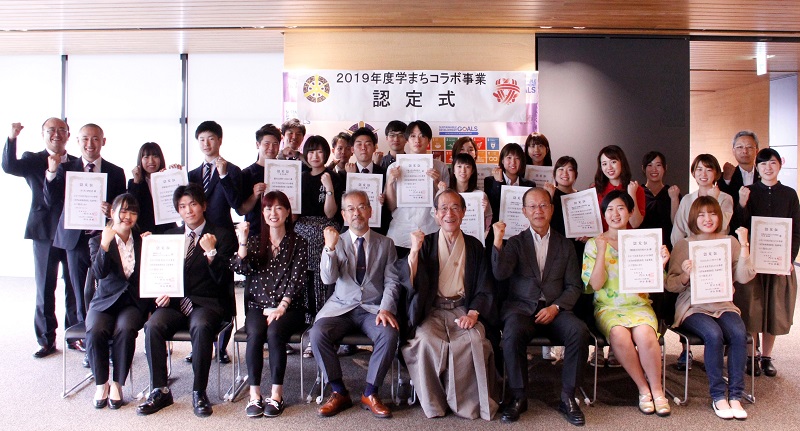
Learning Town NEWS!
We introduce the initiatives of the projects adopted in the Gakumachi Collaboration Project from time to time.
Inquiries
University Consortium Kyoto Gakumachi Collaboration Project
TEL :075-353-9130 FAX: 075-353-9101
MAIL:gakumachi-admin-ml■consortium.or.jp
(Please change ■ to @ and send)
〒600-8216 Shimogyo-ku, Kyoto-shi, Nishitoin-dori, Shiokoji, Shimo-ku, Kyoto, Campus Plaza Kyoto
* Reception hours: Tuesday ~ Saturday 9:00 ~ 17:00














